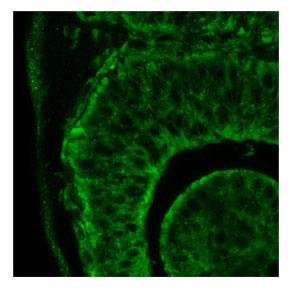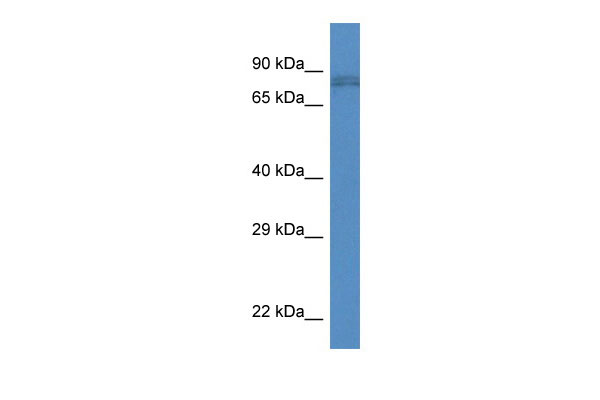Itgb1 antibody - C-terminal region
Rabbit Polyclonal Antibody
- 产品详情
- 实验流程
Application
| WB, IHC |
|---|---|
| Primary Accession | P09055 |
| Other Accession | NM_010578, NP_034708 |
| Reactivity | Human, Mouse, Rat, Rabbit, Zebrafish, Pig, Goat, Dog, Guinea Pig, Horse, Bovine, Sheep |
| Predicted | Mouse, Rat, Rabbit, Zebrafish, Pig, Chicken, Dog, Guinea Pig, Horse |
| Host | Rabbit |
| Clonality | Polyclonal |
| Calculated MW | 88231 Da |
| Gene ID | 16412 |
|---|---|
| Alias Symbol | 4633401G24Rik, AA409975, AA960159, CD29, Fnrb, gpIIa, Gm9863, ENSMUSG00000051907 |
| Other Names | Integrin beta-1, Fibronectin receptor subunit beta, VLA-4 subunit beta, CD29, Itgb1 |
| Format | Liquid. Purified antibody supplied in 1x PBS buffer with 0.09% (w/v) sodium azide and 2% sucrose. |
| Reconstitution & Storage | Add 50 ul of distilled water. Final anti-Itgb1 antibody concentration is 1 mg/ml in PBS buffer with 2% sucrose. For longer periods of storage, store at 20°C. Avoid repeat freeze-thaw cycles. |
| Precautions | Itgb1 antibody - C-terminal region is for research use only and not for use in diagnostic or therapeutic procedures. |
| Name | Itgb1 {ECO:0000312|MGI:MGI:96610} |
|---|---|
| Function | Integrins alpha-1/beta-1, alpha-2/beta-1, alpha-10/beta-1 and alpha-11/beta-1 are receptors for collagen. Integrins alpha-1/beta-1 and alpha-2/beta-2 recognize the proline-hydroxylated sequence G-F-P-G- E-R in collagen. Integrins alpha-2/beta-1, alpha-3/beta-1, alpha- 4/beta-1, alpha-5/beta-1, alpha-8/beta-1, alpha-10/beta-1, alpha- 11/beta-1 and alpha-V/beta-1 are receptors for fibronectin. Alpha- 4/beta-1 recognizes one or more domains within the alternatively spliced CS-1 and CS-5 regions of fibronectin. Integrin alpha-5/beta-1 is a receptor for fibrinogen. Integrin alpha-1/beta-1, alpha-2/beta-1, alpha-6/beta-1 and alpha-7/beta-1 are receptors for lamimin. Integrin alpha-6/beta-1 (ITGA6:ITGB1) is present in oocytes and is involved in sperm-egg fusion (PubMed:10634791, PubMed:36812915). Integrin alpha- 4/beta-1 is a receptor for VCAM1 and recognizes the sequence Q-I-D-S in VCAM1. Integrin alpha-9/beta-1 is a receptor for VCAM1, cytotactin and osteopontin. It recognizes the sequence A-E-I-D-G-I-E-L in cytotactin. Integrin alpha-3/beta-1 is a receptor for epiligrin, thrombospondin and CSPG4. Integrin alpha-3/beta-1 provides a docking site for FAP (seprase) at invadopodia plasma membranes in a collagen-dependent manner and hence may participate in the adhesion, formation of invadopodia and matrix degradation processes, promoting cell invasion. Alpha-3/beta-1 may mediate with LGALS3 the stimulation by CSPG4 of endothelial cells migration. Integrin alpha-V/beta-1 is a receptor for vitronectin. Beta-1 integrins recognize the sequence R-G-D in a wide array of ligands. When associated with alpha-7/beta-1 integrin, regulates cell adhesion and laminin matrix deposition (PubMed:12941630). Involved in promoting endothelial cell motility and angiogenesis (PubMed:15181153). Involved in osteoblast compaction through the fibronectin fibrillogenesis cell-mediated matrix assembly process and the formation of mineralized bone nodules (PubMed:21768292). May be involved in up-regulation of the activity of kinases such as PKC via binding to KRT1. Together with KRT1 and RACK1, serves as a platform for SRC activation or inactivation. Plays a mechanistic adhesive role during telophase, required for the successful completion of cytokinesis (PubMed:18804435). ITGA4:ITGB1 binds to fractalkine (CX3CL1) and may act as its coreceptor in CX3CR1-dependent fractalkine signaling (By similarity). ITGA4:ITGB1 and ITGA5:ITGB1 bind to PLA2G2A via a site (site 2) which is distinct from the classical ligand-binding site (site 1) and this induces integrin conformational changes and enhanced ligand binding to site 1 (By similarity). ITGA5:ITGB1 acts as a receptor for fibrillin-1 (FBN1) and mediates R-G- D-dependent cell adhesion to FBN1 (By similarity). ITGA5:ITGB1 acts as a receptor for fibronectin FN1 and mediates R-G-D-dependent cell adhesion to FN1 (By similarity). ITGA5:ITGB1 is a receptor for IL1B and binding is essential for IL1B signaling (By similarity). ITGA5:ITGB3 is a receptor for soluble CD40LG and is required for CD40/CD40LG signaling (By similarity). Plays an important role in myoblast differentiation and fusion during skeletal myogenesis (By similarity). ITGA9:ITGB1 may play a crucial role in SVEP1/polydom-mediated myoblast cell adhesion (PubMed:22654117). Integrins ITGA9:ITGB1 and ITGA4:ITGB1 repress PRKCA- mediated L-type voltage-gated channel Ca(2+) influx and ROCK-mediated calcium sensitivity in vascular smooth muscle cells via their interaction with SVEP1, thereby inhibit vasocontraction (PubMed:35802072). |
| Cellular Location | Cell membrane {ECO:0000250|UniProtKB:P05556}; Single-pass type I membrane protein. Cell projection, invadopodium membrane {ECO:0000250|UniProtKB:P05556}; Single-pass type I membrane protein. Cell projection, ruffle membrane {ECO:0000250|UniProtKB:P05556}; Single-pass type I membrane protein. Recycling endosome. Melanosome {ECO:0000250|UniProtKB:P05556} Cell projection, lamellipodium {ECO:0000250|UniProtKB:P05556}. Cell projection, ruffle {ECO:0000250|UniProtKB:P05556}. Cell junction, focal adhesion {ECO:0000250|UniProtKB:P05556}. Note=Colocalizes with ITGB1BP1 and metastatic suppressor protein NME2 at the edge or peripheral ruffles and lamellipodia during the early stages of cell spreading on fibronectin or collagen. Translocates from peripheral focal adhesions to fibrillar adhesions in an ITGB1BP1-dependent manner. Enriched preferentially at invadopodia, cell membrane protrusions that correspond to sites of cell invasion, in a collagen-dependent manner Localized at plasma and ruffle membranes in a collagen-independent manner. {ECO:0000250|UniProtKB:P05556} |
| Tissue Location | Expressed in the media layer of the arterial wall (at protein level). [Isoform 2]: Expressed in skeletal and cardiac muscles only (at protein level). |
Research Areas
For Research Use Only. Not For Use In Diagnostic Procedures.
Application Protocols
Provided below are standard protocols that you may find useful for product applications.
REFERENCES
Tominaga S.,et al.FEBS Lett. 238:315-319(1988).
Carninci P.,et al.Science 309:1559-1563(2005).
Church D.M.,et al.PLoS Biol. 7:E1000112-E1000112(2009).
Mural R.J.,et al.Submitted (JUL-2005) to the EMBL/GenBank/DDBJ databases.
Holers V.M.,et al.J. Exp. Med. 169:1589-1605(1989).
终于等到您。ABCEPTA(百远生物)抗体产品。
点击下方“我要评价 ”按钮提交您的反馈信息,您的反馈和评价是我们最宝贵的财富之一,
我们将在1-3个工作日内处理您的反馈信息。
如有疑问,联系:0512-88856768 tech-china@abcepta.com.























 癌症的基本特征包括细胞增殖、血管生成、迁移、凋亡逃避机制和细胞永生等。找到癌症发生过程中这些通路的关键标记物和对应的抗体用于检测至关重要。
癌症的基本特征包括细胞增殖、血管生成、迁移、凋亡逃避机制和细胞永生等。找到癌症发生过程中这些通路的关键标记物和对应的抗体用于检测至关重要。 为您推荐一个泛素化位点预测神器——泛素化分析工具,可以为您的蛋白的泛素化位点作出预测和评分。
为您推荐一个泛素化位点预测神器——泛素化分析工具,可以为您的蛋白的泛素化位点作出预测和评分。 细胞自噬受体图形绘图工具为你的蛋白的细胞受体结合位点作出预测和评分,识别结合到自噬通路中的蛋白是非常重要的,便于让我们理解自噬在正常生理、病理过程中的作用,如发育、细胞分化、神经退化性疾病、压力条件下、感染和癌症。
细胞自噬受体图形绘图工具为你的蛋白的细胞受体结合位点作出预测和评分,识别结合到自噬通路中的蛋白是非常重要的,便于让我们理解自噬在正常生理、病理过程中的作用,如发育、细胞分化、神经退化性疾病、压力条件下、感染和癌症。







